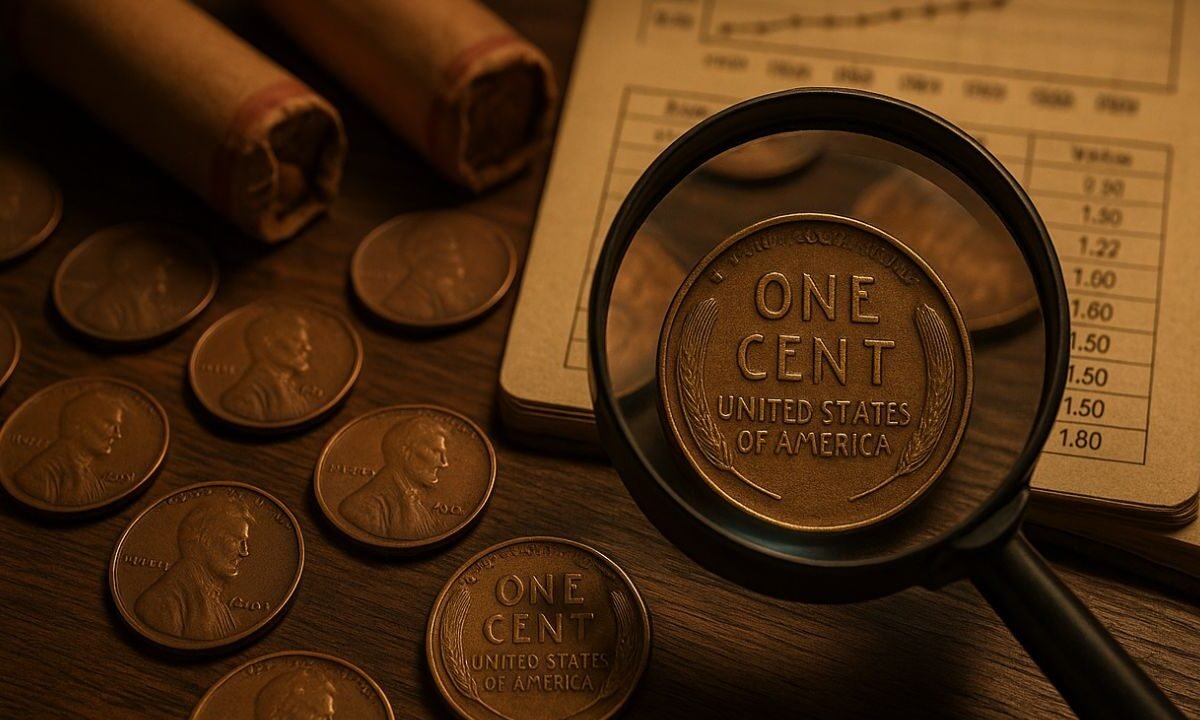If you’ve ever fished out an old penny and wondered whether it might be worth more than a cent, you’re not alone. Wheat pennies—officially known as Lincoln Wheat Cents—were minted from 1909 to 1958 and remain a favorite among collectors.
Their value depends heavily on year, mint mark, condition, and rarity (including errors and varieties).
In 2025, these coins continue to be traded and collected—some common examples fetch only a few cents, while rare ones can command tens or even hundreds of thousands of dollars.
In this guide, you’ll find a value chart for key years, tips on how to evaluate your coins, and insight into which pieces could be especially valuable.
What Are Wheat Pennies & Why They Matter
Wheat pennies feature Abraham Lincoln’s portrait on the obverse and two wheat stalks on the reverse (hence the name). They were composed mostly of copper (with small amounts of tin and zinc), except in rare cases of wartime error issues.
Some years and mint marks produced very low quantities, making those coins rare. Moreover, coins with minting errors—like doubled dies or missing mint marks—gain extra collector appeal.
The value of a wheat penny is determined by these factors:
- Year and Mint Mark: Coins with “S” (San Francisco) or “D” (Denver) can be more valuable than no mark (Philadelphia).
- Condition / Grade: Coins are graded on a scale from “Good” up to “Mint State.” Higher condition = higher value.
- Errors / Varieties: Mistakes like double strikes, missing mint marks, or unusual planchet material can massively boost value.
- Demand & Rarity: The fewer coins known in high grade, the more collectors are willing to pay.
Key Years & Approximate Values in 2025
Below is a table of some notable wheat pennies, their mint marks, and rough values assuming a modest “Good” or circulated condition. Coins in better condition or with error attributes may sell for much more.
| Year | Mint Mark | Estimated Value (Circulated / Good Condition) | Why It’s Notable / Extra Value Potential |
|---|---|---|---|
| 1909-S | S | $75 – $400 | Early San Francisco strike; limited mintage |
| 1909-S VDB | S | $600 – $2,000+ | Includes designer’s initials on reverse |
| 1914-D | D | $150 – $1,000+ | Low mintage in Denver |
| 1922 (no D) | — | $20 – $500+ | Missing mint mark variety (Denver mint error) |
| 1931-S | S | $50 – $200 | Low mintage San Francisco issue |
| 1955 Doubled Die (Phila) | — | $800 – $2,000+ | Famous doubling error on date and lettering |
These values are baseline estimates. In uncirculated or error condition, values could be far higher. For example, an uncirculated 1909-S VDB might fetch several thousand dollars.
One of the most extraordinary cases is the 1943 bronze (copper) wheat penny, an error coin produced by accident during World War II (when most pennies were made of steel). Such coins have sold for hundreds of thousands of dollars in recent years.
Rarest & Most Valuable Wheat Pennies to Watch
If you want to go hunting for “magic” coins, keep an eye out for these:
- 1909-S VDB – perhaps the most famous rare wheat penny.
- 1914-D – especially in higher grades.
- 1922 “Plain” (no D) – missing mint mark error.
- 1943 Bronze Steel Errors – most 1943 pennies were steel; bronze versions are extremely rare.
- 1955 Doubled Die – visible doubling of the date/letters.
Collectors often look for these and pay premiums for well-preserved examples.
How to Assess and Grade Your Wheat Penny
- Identify the Year & Mint Mark
Look just under the date for “D” or “S.” No mark generally means Philadelphia. - Judge Condition / Grade
Use categories like Good (worn), Fine, Very Fine, Extremely Fine, or Mint State (uncirculated). - Look for Errors / Varieties
Double strikes, missing mint marks, repunched mint marks, or unusual planchet (metal) can boost value. - Consult Recent Sale Data
Use online price guides and auction results to see what similar coins sold for recently. - Get Professional Authentication
Especially for higher-value coins, third-party grading services like PCGS or NGC can certify condition and authenticity.
Tips for Collecting & Finding Wheat Pennies
- Check pocket change or old penny rolls—sometimes gems hide in circulation.
- Use a magnifier or loupe to spot subtle mint marks or doubling.
- Store coins in protective holders; avoid cleaning them, which can damage value.
- Join collector forums or coin clubs to learn, trade, and compare.
- Start with common dates (1940s–1950s) before hunting for rare key dates.
The Wheat Penny Value Chart by Year helps demystify what old pennies might be worth in 2025. While many remain modest in value, a few standout coins—like the 1909-S VDB, 1914-D, 1922 no D, 1955 Doubled Die, and rare wartime errors—offer serious upside.
The key to success is identifying mint marks, condition, and errors, then comparing recent sales or getting professional grading.
FAQs
Are most wheat pennies worth money?
No. The vast majority of wheat pennies are worth only their face value or a few cents over it, especially if they’re heavily worn and lack rare features. Only those from key years, with minting errors, or in excellent condition tend to command significant premiums.
How much can a rare wheat penny sell for?
Some rare wheat pennies have sold for hundreds of thousands of dollars, especially error varieties like the 1943 bronze or high-grade 1909-S VDB. But most don’t reach those heights.
Should I have my wheat penny graded?
If you believe your coin is rare or in excellent condition, yes—professional grading (like PCGS or NGC) can help prove authenticity and often increase its market value.

